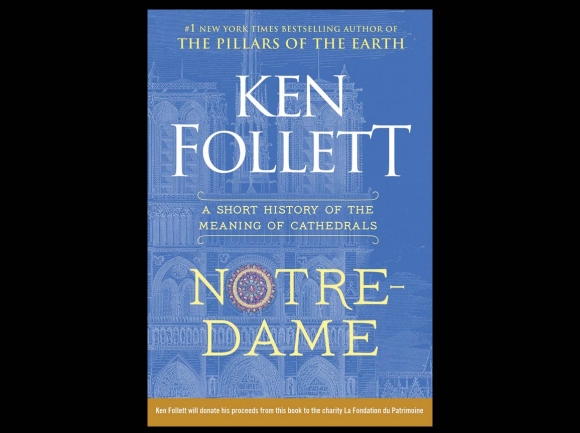Ken Follett’s tribute to Notre Dame

On April 15, 2019, Notre-Dame de Paris, one of the world’s most beloved architectural landmarks, caught fire. The blaze started in the roof, incinerating the enormous ancient wooden beams located there and causing the collapse of the central spire, which “leaned sideways, snapped like a matchstick, and crashed through the flaming roof of the nave.”
That description comes from Ken Follett’s Notre-Dame: A Short History of the Meaning of Cathedrals (Viking, 2019, 62 pages).
Many readers have become fans of this prolific author’s novels over the years, particularly his thrillers and his historical novels, including the best-selling Pillars of the Earth trilogy centered on an English cathedral and its place in the fictional village of Kingsbridge from medieval to Elizabethan times. A prequel set in 997 A.D., The Evening and the Morning, was released in 2020.
During his research for Pillars of the Earth, Follett visited many European cathedrals, studying everything from the building materials used in their construction to all the laborious tasks performed by those who built these incredible structures.
After a friend called on the evening of April 15th and told him to turn on his television, Follett describes his emotions as he watched the catastrophe unfolding in Paris:
“The scene dazed and disturbed us profoundly. I was on the verge of tears. Something priceless was dying in front of our eyes. The feeling was bewildering, as if the earth was shaking.”
Related Items
Almost immediately, Follett flew to Paris, where he spoke on a French television show of his love for these churches and the place they held in his heart. Just before returning to England, he also met with his French publisher, who asked if he would write a book about Notre-Dame, with the profits going to the rebuilding fund. Follett replied, “I’ll start tomorrow,” and by April 26 he had finished his tribute to Notre-Dame.
Into this slim volume Follett jams an enormous amount of information about this great cathedral, its decades-long construction, periods of repair, particularly the damage done by radicals in the French Revolution, and its place as a symbol of freedom when the Allies occupied Paris in 1944. He also gives us thumbnail sketches of other authors entranced by these ancient places of worship, like Victor Hugo whose Hunchback of Notre-Dame was not only a best selling novel but also “has been made into at least thirteen films, five television series, five plays, fifteen stage musicals, five ballets, two BBC radio series, and a video game.”
Here, too, Follett recounts the dramatic entry of French leader Charles De Gaulle into Notre-Dame to attend Mass when Germans were still offering sporadic resistance to Allied troops. De Gaulle was under fire as he rode in a French-made luxury car to the church. A brief firefight broke out around Notre-Dame on his arrival, and as one observer noted of the congregation, most of whom were on the floor to avoid the gunfire as De Gaulle slowly marched down the nave, “One could see more bottoms than faces.”
Reading Notre-Dame caused me to think of all the art we have lost down through the ages from natural and accidental disasters, iconoclasm, and vengeful destruction. The eradication of the ancient city of Troy, the Christian vandalism of Roman religious shrines, the sack of that most famous of ancient libraries in Alexandria, the Muslim rape of Constantinople, the attacks on Catholic churches during England’s Reformation, the Nazi book burnings, the Chinese cultural Revolution of the 1960s, the Taliban’s looting of Afghanistan’s museums and libraries, even our own toppling of statues in this country: this list barely scratches the surface of artifacts, artwork, and buildings demolished in the name of politics and religion.
As Follett tells us, Notre-Dame was erected in a time when building techniques and available equipment were primitive compared to today, a time, too, when wars, famine, and plague ran rampant. Building “Notre-Dame de Paris took almost one hundred years … and it required hundreds of workers and it cost a fortune. The modern equivalent would be a moon shot.”
And whatever gave life to those flames on April 15th — a worker’s cigarette, a faulty electrical connection, a terrorist’s match, we’re still not really certain — destroyed that monument to beauty in a single day.
That fire drives home this lesson: to destroy is always easier than to create. We should hold that lesson in mind not just in regard to a building, a painting, or a book, but also in our work, our relationships, and our lives.
At the end of his homage to Notre-Dame, Follett reminds us of the power of such a magnificent work of art:
“I believe that a novel is successful to the extent that it touches the emotions of the reader. And something similar may be true of all works of art. It is certainly true of cathedrals. Our encounters with them are emotional. When we see them we are awestruck. When we walk around we are enraptured by their grace and light. When we sit quietly we are possessed by a sense of peace.
“And when one burns, we weep.”
(Jeff Minick reviews books and has written four of his own: two novels, Amanda Bell and Dust On Their Wings, and two works of nonfiction, Learning As I Go and Movies Make the Man. This email address is being protected from spambots. You need JavaScript enabled to view it.)









